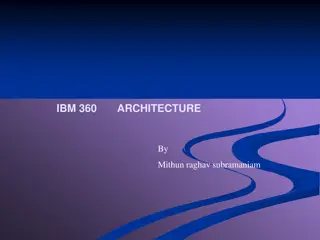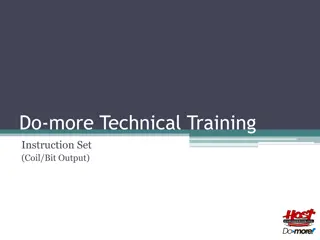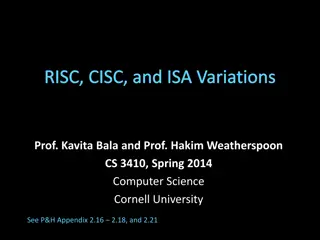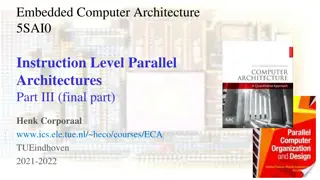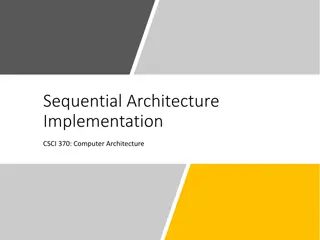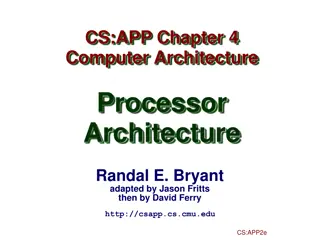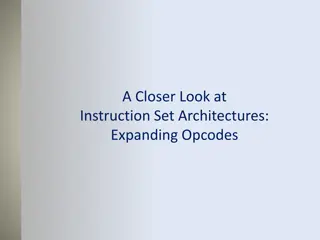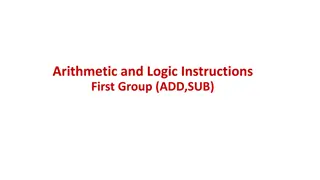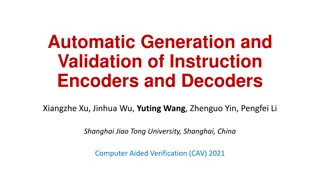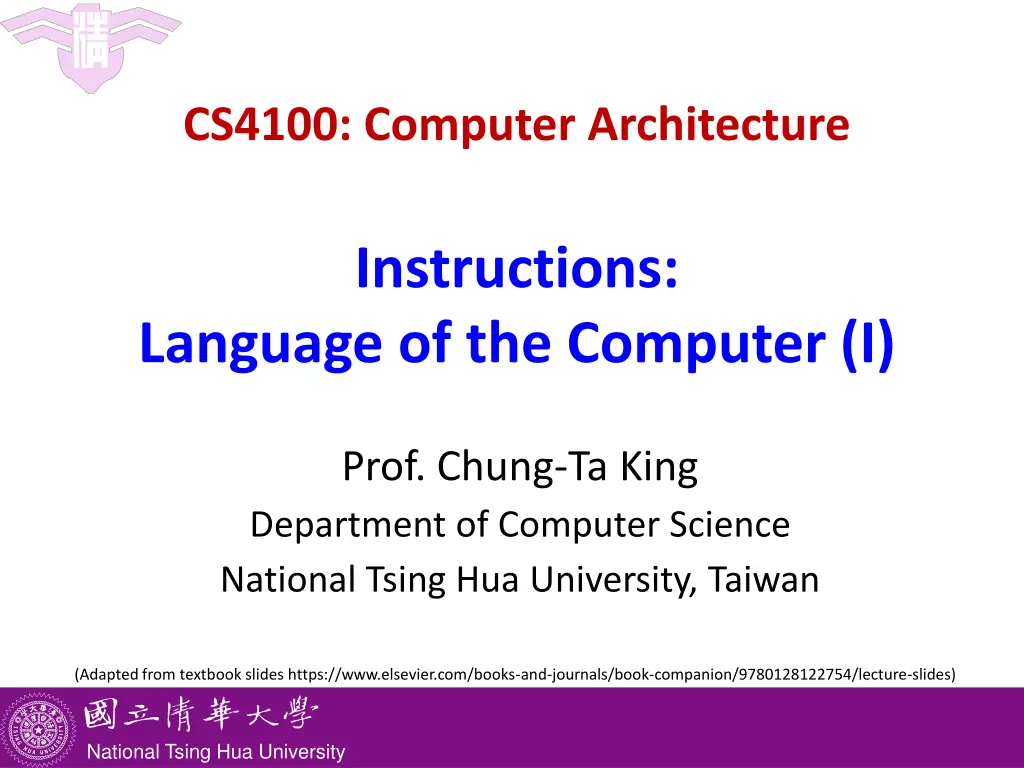
Computer Architecture and Language: Understanding the Language of Computers
Explore the language of computers through high-level and assembly languages, computer hardware operations, operands, registers, and more. Learn about control signals, memory, and instructions that form the vocabulary of computer languages.
Download Presentation

Please find below an Image/Link to download the presentation.
The content on the website is provided AS IS for your information and personal use only. It may not be sold, licensed, or shared on other websites without obtaining consent from the author. If you encounter any issues during the download, it is possible that the publisher has removed the file from their server.
You are allowed to download the files provided on this website for personal or commercial use, subject to the condition that they are used lawfully. All files are the property of their respective owners.
The content on the website is provided AS IS for your information and personal use only. It may not be sold, licensed, or shared on other websites without obtaining consent from the author.
E N D
Presentation Transcript
CS4100: Computer Architecture Instructions: Language of the Computer (I) Prof. Chung-Ta King Department of Computer Science National Tsing Hua University, Taiwan (Adapted from textbook slides https://www.elsevier.com/books-and-journals/book-companion/9780128122754/lecture-slides) National Tsing Hua University
Introduction To command a computer, you must speak its language Most computers understand high-level languages (HLL), e.g., C, C++, Java, with suitable compilers foo(int v[], int k) { int temp; temp = v[k]; v[k] = v[k]+v[k+1]; v[k+1] = temp; } Variables (memory locations storing date) operands of operators Operators operations on operands How about language to a computer s hardware? Assembly language machine instructions Very close to control signals to control hardware operations 1 National Tsing Hua University
Outline Languages of computers (Sec. 2.1) Operations of computer hardware (Sec. 2.2) Operands of computer hardware (Sec. 2.3, 2.4) Registers, memory, signed and unsigned numbers Representing instructions (Sec. 2.5) More operations: logic, decision making (Sec. 2.6, 2.7) Supporting procedures in hardware (Sec. 2.8) More operand representations (Sec. 2.9, 2.10) Characters, wide immediates and addresses Parallelism and instructions (Sec. 2.11) Translating and starting a program (Sec. 2.12) 2 National Tsing Hua University
Outline A C sort example to put it all together (Sec. 2.13) Arrays versus pointers (Sec. 2.14) Compiling C and interpreting Java (Sec. 2.15) Other ISAs: MIPS, x86 (Sec. 2.16, 2.17) The rest of RISC-V (Sec. 2.18) Fallacies and pitfalls (Sec. 2.19) 3 National Tsing Hua University
Outline Languages of computers (Sec. 2.1) Operations of computer hardware (Sec. 2.2) Operands of computer hardware (Sec. 2.3, 2.4) Registers, memory, signed and unsigned numbers Representing instructions (Sec. 2.5) More operations: logic, decision making (Sec. 2.6, 2.7) Supporting procedures in hardware (Sec. 2.8) More operand representations (Sec. 2.9, 2.10) Characters, wide immediates and addresses Parallelism and instructions (Sec. 2.11) Translating and starting a program (Sec. 2.12) 4 National Tsing Hua University
Language to Computer Hardware Control Datapath 0111 Register 0011 Control signals 0100 Memory 01001101 10110100 ALU + Controller N Z clock IR PC 10110100 add r1,r2,r3 01001101 Instruction: words of a computer s language Instruction set: vocabulary of the language 5 National Tsing Hua University
Language to Computer Hardware Different computers have different languages (instruction sets) But with many aspects in common Because all computers are constructed from hardware technologies based on similar underlying principles Because there are a few basic operations that all computers must provide Makes it easy to build the hardware and the compiler while maximizing performance and minimizing cost and energy Combinations of these basic operations allow a computer to run all sorts of programs written in various HLLs What are the most basic operations and how to specify them? 6 National Tsing Hua University
Essentially, We Are Asking What must be specified in an instruction set architecture (ISA)? ISA encompasses all the information necessary to write a machine language program that will run correctly Including: operations: +, -, *, /, ... operands (data, address) flow control SW Application Operating System Compiler Assembler ISA HW Processor Memory I/O System What are included in ISA and how are they specified have profound effects on computer design! Datapath & Control Digital Design Circuit Design Transistors 7 National Tsing Hua University
Components of an ISA Storage and data: (operands) Organization of programmable storage: Registers: # of bits, # of registers, their roles, Memory: addressing, access methods, Data types and data structures Integers, floating-point, text, signed number, Operations on data and execution flow control: Instruction set (or operation code) ALU, control transfer, exceptional handling Instruction specification: Instruction format and encoding 8 National Tsing Hua University
Use 64-bit RISC-V (RV64) as an Example Developed at UC Berkeley as open ISA Now managed by the RISC-V Foundation (riscv.org) Typical of many modern ISAs Similar ISAs have a large share of embedded core market Applications in consumer electronics, network/storage equipment, cameras, printers, We will not only describe what the RISC-V ISA is But also study the principles behind the design And examine some different design options to appreciate why RISC-V chooses the specific option 9 National Tsing Hua University
Outline Languages of computers (Sec. 2.1) Operations of computer hardware (Sec. 2.2) Operands of computer hardware (Sec. 2.3, 2.4) Registers, memory, signed and unsigned numbers Representing instructions (Sec. 2.5) More operations: logic, decision making (Sec. 2.6, 2.7) Supporting procedures in hardware (Sec. 2.8) More operand representations (Sec. 2.9, 2.10) Characters, wide immediates and addresses Parallelism and instructions (Sec. 2.11) Translating and starting a program (Sec. 2.12) 10 National Tsing Hua University
What Basic Operations for Hardware? 1. Operations to work on data Arithmetic (+, -, *, /), logic (&, |, ~) similar to a function, e.g. z=f(x,y), operating on values 2-operand (a + b), 1-operand (++a) 2. Operations to move and copy data between storage locations As storage, original location still retains the data, until explicitly overwritten 3. Operations to change execution flow Unconditional: goto, jump to new location to execute Conditional: if-then-else, jump if condition is true Procedural: foo(), similar to goto but need to come back 11 National Tsing Hua University
Lets Start with Arithmetic Operations The most basic operation for any computer hardware is arithmetic operation on numbers, e.g., a = b + c Basic RISC-V arithmetic instructions are specified as: add a,b,c # a All RISC-V arithmetic instructions have this form 3-address: a, b, c are storage locations that hold data, but c may also be a value Design Principle 1: Simplicity favors regularity Regularity makes implementation simpler Simplicity enables higher performance at lower cost b + c Why storage concept indispensable? 12 National Tsing Hua University
Arithmetic Instruction Example C code: f = (g + h) - (i + j); Compiled RISC-V (pseudo) code: add t0, g, h # temp t0 add t1, i, j # temp t1 sub f, t0, t1 # f t0 and t1 are temporary variables, i.e., storage locations, normally allocated by the compiler g + h i + j t0 - t1 13 National Tsing Hua University
Why 3-Address Format: add a,b,c? Why not 2-address format? add b,c # b Still regular, and one address less to specify and encode! b + c How about 0-address format? add Where to get the operands? must be specified implicitly so that the computer hardware knows where to get, e.g. in a stack add #stack[top] stack[top]+stack[next] Tradeoff between flexibility and complexity 14 National Tsing Hua University
Outline Languages of computers (Sec. 2.1) Operations of computer hardware (Sec. 2.2) Operands of computer hardware (Sec. 2.3, 2.4) Registers, memory, signed and unsigned numbers Representing instructions (Sec. 2.5) More operations: logic, decision making (Sec. 2.6, 2.7) Supporting procedures in hardware (Sec. 2.8) More operand representations (Sec. 2.9, 2.10) Characters, wide immediates and addresses Parallelism and instructions (Sec. 2.11) Translating and starting a program (Sec. 2.12) 15 National Tsing Hua University
Operands to an Operation 3 Operands may be the value itself (immdiates) add a,b,3 or the storage location holding the value add a,b,c The storages that can hold values may be in memory or in registers Registers are a small number of storage locations built directly into CPU hardware; memory refers to storage locations in the main memory need to specify addresses How about disk? Why not disk locations as operands? RISC-V arithmetic instructions must use register operands! 2 1 16 National Tsing Hua University
Why Restricted to Register Operands? Why not allow memory operands, too? add M[1000],M[2019],M[2020] Design Principle 2: Smaller is faster Register vs. main memory (millions of locations) Registers are inside CPU same clock as CPU, connect directly to arithmetic units, short and fast signals Registers are small easy to activate to access data, short and fast signals Registers are small fewer number of bits to specify and encode smaller instructions Suitable for holding frequently accessed data 17 National Tsing Hua University
How to Specify (1) Register Operands? Must know RISC-V register organization! RISC-V has a 32 64-bit register file 32 registers specified as x0 to x30, each with a 5-bit addr doubleword x0 constant 0 x10 x11 function arguments/results x1 return address x12 x2 stack pointer function arguments x3 global pointer x17 x4 thread pointer x5 temporaries x18 saved registers x27 Why not 64, or 16? x7 x28 x8 frame pointer temporaries x9 saved registers x31 18 National Tsing Hua University
Register Operand Example How to do the following C statement? f = (g + h) - (i + j); Assume that f, g, h, i, j are in x19, x20, x21, x22, x23 Use intermediate temporary registers x5, x6 add x5,x20,x21 add x6,x22,x23 sub x19,x5,x6 If data are in the memory, they must be loaded into the registers first before arithmetic operations can be operated on them; after operations, they need to be stored back # x5 # x6 # f g + h i + j x5 x6 Use data transfer instructions (ld, sd, ...) discussed later 19 National Tsing Hua University
How to Specify (2) Memory Operands? Must know RISC-V memory organization! Main memory is organized as a 1D array of locations Each location can hold one byte of data and is identified by an address memory is byte addressed, i.e. each address identifies an 8-bit byte of data, ranging from 0 to 261 A nature way of specifying memory operands in RISC- V is like addressing an array, e.g., A[100] A is the base address and 100 is the offset and memory address of A[100] is (A + 100) In RISC-V, memory operand is specified as: 100(x22), where x22 contains base addr. and 100 is offset (in bytes) A memory operand normally gets a doubleword (64 bits), and thus word addresses differ by 8 20 National Tsing Hua University
Memory Operand Example C code: A[9] = h + A[8]; h in x21, base address of A in x22 A[8]: the 8th doubleword in array A[], which is at the 64th byte from start of A[] 264 - 1 A[9] = 1096 A[8] = 1088 Compiled RISC-V code: ld x9, 64(x22) add x9, x21, x9 sd x9, 72(x22) A = 1024 load doubleword 0 store doubleword base register offset 21 National Tsing Hua University
Registers and Memory Size Memory 64 bit address data RISC-V I64 CPU 0x 0000 0000 0000 0000 0x 0000 0000 0000 0001 x0 0 0x 0000 0000 0000 0002 x1 double word =64 bits 0x 0000 0000 0000 0003 x2 0x 0000 0000 0000 0004 0x 0000 0000 0000 0005 x31 0x 0000 0000 0000 0006 0x 0000 0000 0000 0007 double word=64 bits 5 bits for register ID 0x FFFF FFFF FFFF FFFF Note: actual physical address bits are less than 64, e.g., 42 for Intel x86_64 1byte=8bits (Prof. Jing-Jia Liou) 22 National Tsing Hua University
More about RISC-V Memory Organization RISC-V is Little Endian Least-significant byte at least address of a word c.f. Big Endian: most-significant byte at least address (By R. S. Shaw - Own work, Public Domain, https://commons.wikimedia.org/w/index.php?curid=2974661) 23 National Tsing Hua University
More about RISC-V Memory Organization RISC-V does not require words to be aligned in memory, i.e., at an address a multiple of 4 (for a word) or 8 (for a doubleword) Unlike some other ISAs; but misaligned memory accesses may be very very slow 0 1 2 3 264 - 1 Not A[9] = 1096 Aligned Aligned Not Aligned A[8] = 1088 Aligned A = 1024 0 24 National Tsing Hua University
Registers vs. Memory Registers are faster to access than memory But, operating on memory data requires loads and stores More instructions to be executed, larger code size Compilers should use registers for variables as much as possible Only spill to memory for less frequently used variables, if more variables than available registers are used Register optimization is important! Why not keep all variables in memory? Smaller is faster: registers are faster than memory Registers are more versatile: Register file can read 2 and write 1 registers per instruction Memory read/write 1 operand per instruction, no operation 25 National Tsing Hua University
How about (3) Immediate Operands? Small constants used frequently (50% of operands) e.g., A = B + 4; Put 'typical constants' in memory and load them ld x9, AddrConstant4(x3) add x22, x22, x9 Alternative: constant data specified in the instruction addi x22, x22, 8 if (C > 1) ; Too slow Immediate operand Design Principle 3: Make the common case fast Small constants are common Immediate operand avoids a load instruction Why define a new instruction, addi? Why not reuse add? 26 National Tsing Hua University
Handling Constant Zero and Negatives The number zero (0) is so common in code that RISC- V hardwired register 0 (x0) to 0 Cannot be overwritten, e.g., addi x0,x0,5 (no effect) Useful for other common operations, too, e.g., move between registers: add x22, x20, x0 Thus, there is no need to implement a move instruction in hardware simpler CPU design and implementation No need for subtract immediate instruction either Just use a negative constant: addi x22, x22, -8 Time to review signed and unsigned numbers 27 National Tsing Hua University
Represent Unsigned Binary Integers Given an n-bit number 2 x x = + + + + n 1 n 2 1 0 x 2 x 2 x 2 n 1 n 2 1 0 Use all the bits to represent values Example: (32 bits) 0000 0000 0000 0000 0000 0000 0000 10112 = 0 + + 1 23 + 0 22 +1 21 +1 20 = 0 + + 8 + 0 + 2 + 1 = 1110 Range: 0 to +2n 1 Using 32 bits: 0 to +4,294,967,295 Using 64 bits: 0 to +18,446,774,073,709,551,615 Can get the max value 28 National Tsing Hua University
Signed Binary Integers (2s-Complement) Given an n-bit number x x = + + + + n 1 n 2 1 0 2 x 2 x 2 x 2 n 1 n 2 1 0 Use bit 31/63 to represent sign (sign bit) 1 for negative and 0 for non-negative numbers Signed negation: complement (1 0, 0 1) & add 1 Non-negative numbers have the same representation ( 2n 1) can t be represented Example: (32 bits) 1111 1111 1111 1111 1111 1111 1111 11002 = 1 231 + 1 230+ + 1 22 +0 21 +0 20 = 2,147,483,648 + 2,147,483,644 = 410 29 National Tsing Hua University
2s-Complement Signed Integers Range: 2n 1 to +2n 1 1 Using 32 bits: 2,147,483,648 to +2,147,483,647 Using 64 bits: 9,223,372,036,854,775,808 (1000 00002) to 9,223,372,036,854,775,807 (0111 1111 11112) 0: 0000 0000 00002 1: 1111 1111 11112 (least negative number) Most-negative number (1000 00002) does not have a corresponding positive number Why 2 s complement? One adder, no distinction SW interprets meaning Signed/unsigned +/- treated the same! 30 National Tsing Hua University
Sign Extension Representing a number using more bits while preserving the numeric value How to do? replicate the sign bit to the left c.f. unsigned values: extend with 0s Examples: 8-bit to 16-bit +2: 0000 0010 0000 0000 0000 0010 2: 1111 1110 1111 1111 1111 1110 Sign? lb x22,0(x21) FFFFFF F7 In RISC-V instruction set lb: load byte (sign-extend loaded byte) lbu: load byte unsigned (zero-extend loaded byte) lbu x22,0(x21) 000000 F7 31 National Tsing Hua University
Outline Languages of computers (Sec. 2.1) Operations of computer hardware (Sec. 2.2) Operands of computer hardware (Sec. 2.3, 2.4) Registers, memory, signed and unsigned numbers Representing instructions (Sec. 2.5) More operations: logic, decision making (Sec. 2.6, 2.7) Supporting procedures in hardware (Sec. 2.8) More operand representations (Sec. 2.9, 2.10) Characters, wide immediates and addresses Parallelism and instructions (Sec. 2.11) Translating and starting a program (Sec. 2.12) 32 National Tsing Hua University
How to Specify RISC-V Instructions? Now that we have learned operations and operands of computer hardware, let us study how to put them together to form computer instructions Remember: Computer only understands 1s and 0s, so add x21,x22,x23 is meaningless to hardware Instructions to instruct computer hardware how to operate should also be encoded in binary, called machine code RISC-V s strategies for instruction encoding Encode every instruction in 32-bit words, divided into fields Small number of formats encoding operation code (opcode), register numbers, Let s look at three of them first Regularity! Why not just 1 format? 33 National Tsing Hua University
RISC-V R-format Instructions funct7 rs2 rs1 funct3 rd opcode 7 bits 5 bits 5 bits 3 bits 5 bits 7 bits For register to register operations Instruction fields opcode: operation code rd: destination register number funct3: 3-bit function code (additional opcode) rs1: the first source register number rs2: the second source register number funct7: 7-bit function code (additional opcode) Why not combine op and funct? 34 National Tsing Hua University
R-format Example funct7 rs2 rs1 funct3 rd opcode 7 bits 5 bits 5 bits 3 bits 5 bits 7 bits add x9,x20,x21 0 x21 x20 0 x9 add 0 21 20 0 9 51 0000000 10101 10100 000 01001 0110011 0000 0001 0101 1010 0000 0100 1011 0011two = 015A04B316 35 National Tsing Hua University
RISC-V I-format Instructions immediate rs1 funct3 rd opcode 12 bits 5 bits 3 bits 5 bits 7 bits Immediate arithmetic and load instructions rs1: source or base address register number immediate: constant operand, or byte offset to base addr 2 s-complement, sign extended, 211 to 211 1 Design Principle 3: Good design demands good compromises Different formats complicate decoding, but allow 32-bit instructions uniformly Keep formats as similar as possible (only 1 field differs) 36 National Tsing Hua University
I-Format Example 1 RISC-V instruction: addi x9,x22,-50 opcode = 19 (look up in RISC-V Manual) rs1 = 22 (source operand register number) rd = 9 (destination register number) immediate = -50 (by default, this is decimal) Decimal representation: -51 22 0 9 19 Binary representation: 1111 1100 1101 10110 000 01001 0010011 37 National Tsing Hua University
I-Format Example 2 RISC-V instruction: ld x9,120(x22) opcode = 3 (look up in RISC-V Manual) rs1 = 22 (base address register number) rd = 9 (destination register number) immediate = 120 (offset) Decimal representation: 120 22 3 9 3 Binary representation: 0000 0111 1000 10110 011 01001 0000011 38 National Tsing Hua University
RISC-V S-format Instructions imm[11:5] rs2 rs1 funct3 imm[4:0] opcode 7 bits 5 bits 5 bits 3 bits 5 bits 7 bits Different immediate format for store instructions rs1: base address register number rs2: source operand register number immediate: offset added to base address Split so that rs1 and rs2 fields always in the same place RISC-V instruction: sd x9,120(x22) 120-1 9 22 3 120-2 35 0000011 01001 10110 011 11000 0100011 National Tsing Hua University
Key Computer Design Principles Computer instructions represented as numbers Program instructions can be stored at the same place as data (in memory) and be manipulated in the same way as data stored-program computer Instructions and data look the same, just 0s and 1s Differ only in how you interpret the bits One consequence: everything addressed Everything has a memory address: instructions, data Both branches and jumps use these One register keeps address of the instruction being executed: Program Counter (PC) Register can hold any 64-bit value, (signed) int, address, etc. 40 National Tsing Hua University
Stored-Program Computers Consequence #2: programs can operate on programs e.g., compilers, linkers, The latter is data to the former Consequence #3: binary compatibility Programs can be shipped as files of binary numbers and executed on any computers with a compatible ISA Consequence #4: fast context switches of processes Fig. 2.7 41 National Tsing Hua University
Stored Program with Memory Access load instr. Memory address instruction/data CPU Instruction Register add x9, x20, x21 1 2 ld x20, 0(x10) ld x21, 0(x11) add x9, x20, x21 3 4 1 10 adder sd x9, 0(x12) 20 2 b 10 30 3 c 20 4 (1) load b to x18=10 (2) load c to x19=20 (3) add x9=x18+x19 (4) store x9 to a a 30 Assume x10=b s address x11=c s address x12=a s address (Prof. Jing-Jia Liou) 42 National Tsing Hua University
Instruction and Data Encoding (in Hex) Memory address instruction/data CPU Instruction Register 00053A0316 015A04B316 0005BA8316 015A04B316 0000000A16 adder 0096302316 0000001416 b 0000000A16 0000001E16 c 0000001416 Assume x10=b s address x11=c s address x12=a s address a 0000001E16 (Prof. Jing-Jia Liou) 43 National Tsing Hua University
Outline Languages of computers (Sec. 2.1) Operations of computer hardware (Sec. 2.2) Operands of computer hardware (Sec. 2.3, 2.4) Registers, memory, signed and unsigned numbers Representing instructions (Sec. 2.5) More operations: logic, decision making (Sec. 2.6, 2.7) Supporting procedures in hardware (Sec. 2.8) More operand representations (Sec. 2.9, 2.10) Characters, wide immediates and addresses Parallelism and instructions (Sec. 2.11) Translating and starting a program (Sec. 2.12) 44 National Tsing Hua University
Bitwise Operations Up until now, we have seen arithmetic (add, addi) and memory access (ld, sd) All of these instructions view contents of register as a single quantity (such as a signed or unsigned integer) New perspective: View contents of register as 64 individual bits rather than as a single 64-bit number Since registers are composed of 64 bits, we may want to access individual bits rather than the whole Introduce two new classes of instructions: Logical operators Shift instructions 45 National Tsing Hua University
Logical and Shift Operations Instructions for bitwise manipulation Useful for extracting and inserting groups of bits in a word Operation C Java RISC-V Shift left << << sll, slli Shift right >> >>> srl, srli Shift right arith. >> >> sra, srai Bitwise AND & & and, andi Bitwise OR | | or, ori Bitwise XOR ^ ^ xor, xori Bitwise NOT ~ ~ Fig. 2.8 46 National Tsing Hua University
Shift Operations sll: shift left logical (R-type) Shift left and fill with 0 bits Shift left by i bits = multiplies by 2i (faster than multiply) funct7 rs2 rs1 funct3 rd opcode 7 bits 5 bits 5 bits 3 bits 5 bits 7 bits Example: sll x9,x20,x21 0 x21 x20 1 x9 sll 0000000 10101 10100 001 01001 0110011 x20= 0000 0001; x21= 0000 0011 = 3 After instruction executed, x9will contain 0000 1000 47 National Tsing Hua University
Shift Operations srl: shift right logical (R-type) Shift right and fill with 0 bits Shift right by i bits = divides by 2i (unsigned only) (much faster than division, used in compiler optimization) Example: srl x9,x20,x21 0000000 10101 10100 101 01001 0110011 sra: shift right arithmetic (R-type) Shift right and fill with sign bits (no sla!) Shift right by i bits = divides by 2i (signed) Example: sra x9,x20,x21 0100000 10101 Note the encoding 10100 101 01001 0110011 x20= 1111 1000; x21= 0000 0011 = 3 After instruction executed, x9 will contain 1111 1111 48 National Tsing Hua University
Shift Immediate Operations slli: shift left logical immediate (32-bit RISC-V: RV32) 0000000 shamt rs1 001 rd 0010011 7 bits 5 bits 5 bits 3 bits 5 bits 7 bits shamt: how many bits to shift 32-bit data can only be shifted 32 bit positions 5-bit shamt Same format as R-type, except rs2 becomes shamt slli: how about 64-bit RISC-V (RV64)? We can shift 64 bit positions and need 6 bits for shamt How? 000000 shamt rs1 001 rd 0010011 6 bits 6 bits 5 bits 3 bits 5 bits 7 bits 49 National Tsing Hua University


